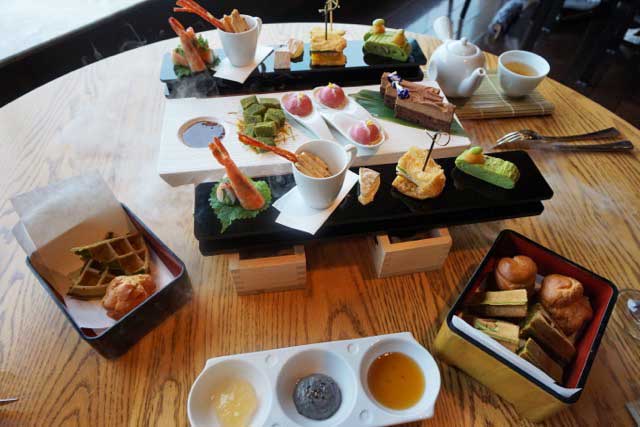By Angela Fairhurst
One writer’s quest for the perfect cup of tea takes her through Hong Kong and Tokyo, resulting in lessons of history, health and wellness.

Tea began as an accident. It happened in China over 5,000 years ago when an early emperor thought drinking water should be boiled as a hygienic precaution. According to legend, while visiting a region of his realm, the servants began boiling water for the court to drink when some leaves from a nearby bush fell into the water and a brown liquid infused. The emperor was intrigued with the refreshing new liquid and tea was born. At first it was only for the wealthy, but expanded to all classes over the years and has become the most popular beverage in the world today.
Westerners have been catching on, partly due to the well-known health benefits such as antioxidants found in green tea, which help prevent heart disease and cancer. My own curiosity about tea was piqued as I prepared to embark on a trip to Hong Kong and Tokyo. Digging into the subject, I discovered it’s more like wine than you’d think. All tea is made from the dried and prepared leaves and stems of the Camellia Sinensis plant, the botanical name of the tea bush. This plant is used for making green, oolong, and black teas. Though the same source plant is used, different processes are used for different teas. Green tea is not fermented, oolong tea is partially fermented, black tea is fully fermented, and Pu-erh tea is post-fermented, and like wine, can be stored to mature for consumption and is commonly labelled with the year and region of production. Pu-erh tea’s medicinal qualities are said to improve mental alertness, sharpen thinking and reduce cholesterol.
Taking a cue from the emperor, I arranged to sample teas at upscale establishments during my journey through Asia. A revelation to me, many posh places employ Tea Sommeliers, experts at tea for pleasure, health and wellness.

YAN TOH HEEN, INTERCONTINENTAL HONG KONG. My introduction to the Tea Sommelier Kelvin Ng was a lesson unto itself. At Yan Toh Heen, one of the finest Cantonese restaurants and recipient of two Michelin stars, I had a stellar lunch where Ng taught me that the Chinese don’t steep their tea, they simply pour the first pour within a minute, and a second pour is of the same length. He proceeded with a detailed description of each and every tea, its qualities, taste at the beginning and the finish. Much like wine, I found myself pondering which one to choose with my meal, and my first choice, a Chrysanthemum blood tea, was too bitter. I couldn’t hide the expression on my face when I sipped the tea. No matter what its positive qualities were, I had to go with the more subtle Jasmine Pearls, a refreshing and relaxing flower tea.

SPRING MOON, THE PENINSULA HONG KONG. Spring Moon, the Peninsula Hong Kong’s traditional Cantonese restaurant, has an impressive dedicated tea counter with a collection of over 200 miniature Chinese clay teapots. They feature over 25 selected Chinese teas with expert tea pairings by the restaurant’s highly trained tea masters. Selections included pan-fried garoupa fillet supreme soy sauce paired with Chao an Mountain Wudong Mono Species and spare ribs and pear with dark vinegar paired with Osmanthus White Peony. The art of tea pairings is truly a delectable science.
NOBU T-SET,INTERCONTINENTAL HONG KONG. I tried Japanese tea in Hong Kong at Nobu, complete with umami (savories) such as yuba bun, spring rolls, Hokkaido cheese and tamagoyaki (Japanese omelette) and sweets such as matcha waffle, Warabi mochi, Amai spoon (pink mousse dome) and pastries. Here guests have a choice of Rishouen green teas, matcha drinks (made of green tea powder) or coffee. The Nobu T-Set came with a fancy special effect, served with dry ice under the bento boxes for a misty grand entrance. Rishouen Tea was established in 1947 in Uji, the birthplace of Japanese tea.


THE LOBBY, THE PENINSULA TOKYO. When afternoon teatime strikes, locals and visitors alike love a simple traditional English Afternoon Tea at The Lobby, a signature restaurant of all Peninsula Hotels. Traditional teas and triple-tier towers filled with a delicious assortment of scones, savory finger sandwiches and sweets grace The Lobby tables daily.
SENSE TEA CORNER, MANDARIN ORIENTAL TOKYO. Enjoying the majestic views of the city of Tokyo on the 37th floor of the Mandarin Oriental is the serene and relaxed setting of the Sense Tea Corner, a tearoom offering more than 20 types of fragrant teas from around the world, including the healing green tea and pu-erh tea for true connoisseurs. The long and the short of it is, even if you like a simple English Breakfast black tea, or a more complex aged mildly fermented Shou Mei tea, drink it, it’s probably good for you.
